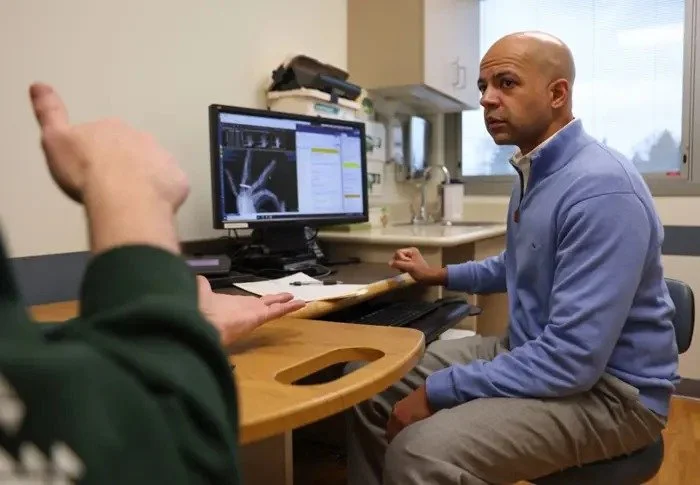Some US doctors increasingly using artificial intelligence to take notes during appointments
It was easy to miss Dr Robert Gray’s quick movements, tapping the screen of his smartphone at the beginning and end of patient visits on a recent day.
But Gray said those fast finger taps have changed his life. He was tapping an app that records discussions during his appointments and then uses artificial intelligence to find the relevant information, summarise it and zap it, within seconds, into each patient’s electronic medical record.
The technology was meticulously documenting each visit so Gray didn’t have to.
“I enjoy working so much more,” said Gray, an Endeavor Health hand surgeon. He’s no longer trying to consult with patients while simultaneously summarising the visits on a computer. “I don’t have the feeling I got hit by a truck every day”.
It’s a technology that’s spreading rapidly throughout doctors’ offices in the Chicago-area and across the US, and could soon become a standard part of medical appointments. Local health care leaders hope the technology will help combat physician burnout by dramatically cutting the amount of time doctors spend on documentation, and they hope it will improve patients’ experiences.
Doctors will be able to spend more time looking patients in the eye, rather than staring at computer screens during appointments, health care leaders say.
“It allows them to get home to be with their families or allows them to focus entirely on the patient,” said Dr Nadim Ilbawi, system medical director of ambulatory innovation for Endeavor.
About 50 of Endeavor’s primary care doctors and specialists have been using the ambient listening technology, made by a company named Abridge, since September.
Other local health systems have taken generative AI note-taking technologies even further.
Northwestern Medicine has about 300 of its physicians using a similar technology offered by Microsoft called DAX Copilot, and Rush University System for Health has about 100 clinicians using DAX Copilot as well as a technology made by another company. At UChicago Medicine, about 550 clinicians are using the Abridge technology, and about 1,300 providers are using DAX Copilot at Advocate Health Care in Illinois and Aurora Health Care in Wisconsin. Beyond Illinois, health care systems Kaiser Permanente and Johns Hopkins Medicine are among those who’ve agreed to offer Abridge across their systems.
Now, the technologies are mostly being used in the Chicago area during appointments with patients in offices and clinics, but several local systems say they plan to soon offer them to doctors in emergency rooms, urgent cares and nurses and to those providing care to patients staying overnight in hospitals. Leaders at the systems say that, so far, they’ve seen positive results from using the technologies, and some say they hope to eventually offer them to all of their providers.
“It’s going to become ubiquitous very soon,” said Dr Nirav S. Shah, associate chief medical informatics officer for AI and innovation at Endeavor.
So far, health systems say it’s been optional for doctors, and they don’t foresee forcing providers to use it. It’s also optional for patients.
Typically, the doctor or medical staff member will ask the patient for permission to use the technology at the start of the appointment. Generally, if the patient says it’s OK, the doctor will then access it through an app on their phone. The doctor can tap their phone screen, and the app will start recording.
The Abridge app records audio of the conversation and then transcribes it. The transcription is then sent to a cloud – neither the transcription nor the recording is stored on the doctor’s phone. Artificial intelligence sorts the relevant parts of the conversation – such as discussion about medical and socioeconomic issues – from small talk and other irrelevant parts, creating notes about the appointment in the patient’s electronic medical record.
The doctor then reviews the notes in the medical record, making sure they’re accurate, and can make changes before signing off on them. The audio or transcript of the appointment is eventually destroyed, leaving only the medical record behind.
So far, Gray said he hasn’t had any patients say no to the technology. Dr Douglas Dorman, a family medicine physician at Advocate Health Care in Yorkville, said he’s had fewer than 10 patients reject the idea since he started using the technology.
Catherine Gregory, who saw Gray on a recent day after undergoing surgery for a broken arm, said it seemed like a good idea as a way to help doctors give patients more of their undivided attention.
“I’mSource: Lisa Schencker, Star Media Group for it,” said Gregory, 62, of Chicago, “because I want his attention on me, especially if I’m in pain, like today. I don’t want you to miss anything I’m saying about the pain I’m in”.
Patient Robert Johnston, 61, of West Rogers Park, said he’d never heard of the technology before visiting Gray. At first, he worried it might be intrusive, especially if he were discussing a sensitive topic with a doctor. But he said he can also see how it could help doctors and patients have better relationships.
“It’s a lot better when they’re able to speak directly to me,” he said of doctors. “As long as privacy concerns are protected, I think it’s a great idea”.
Local health systems said the companies they chose to supply the technologies had to meet the systems’ security and privacy requirements. Breaches and cyberattacks have become common at health systems across the country in recent years.
“We take security very, very, very seriously so it was definitely evaluated strongly,” said Dr Betsy Winga, vice president of medical informatics and chief medical informatics officer for Advocate Health Care and Aurora Health Care.
She said she couldn’t discuss the costs of the technology, but said, “The benefit we have seen from it, from a clinician experience standpoint, is just priceless”.
Overall, Dorman, with Advocate, said patients seem to appreciate it – or at least what it’s meant for their interactions with him. Patients have told him he seems more relaxed and less stressed, he said.
“I get to come back to work each day refreshed, recharged, excited to be there,” Dorman said. “I really think it improves my demeanor”.
Doctors who’ve used the technology say, in some ways, it’s helped them return to an earlier time in medicine, when they didn’t have to spend as much time on documentation. A federal law passed in 2009 incentivised the use of electronic medical records as a way to make records more easily accessible, increase patient privacy and improve patient safety. Later the federal government began penalising providers who didn’t use them in a meaningful way. Doctors say that, over time, the amount of information they’ve had to enter in the records has grown.
In many cases, that’s left doctors with two choices: either try to document patients’ visits during their appointments or finish their documentation at the end of the day, which can often mean hours of extra work.
According to an American Medical Association survey, doctors in 2023 said they worked 59-hour workweeks, on average, and nearly eight hours of that time was devoted to administrative tasks. About 48% of the doctors who responded to the AMA survey reported experiencing at least one symptom of burnout.
Doctors and health care leaders refer to time spent on administrative tasks outside of the workday as “pajama time”. Northwestern saw a 17% decrease in pajama time among its clinicians who used the AI note-taking technology, and Advocate Health Care saw nearly a 15% reduction.
Dorman, with Advocate, said he used to spend 20 to 25 hours a week working on documentation, after hours. He said he used to be the last one to leave the office each day. Now, he said he spends about 30 minutes a week on the task. He said the technology has been “life-changing”.
Before the technology, Dr Melissa Holmes, a pediatrician at Rush, would type some of her notes during the day and others in the evenings, at home, after her kids went to bed. She said she’s still doing some work in the evenings, but it takes much less time to check over and edit the AI notes than it did to type all of her own.
The technology has also helped her be more present with her patients, she said.
“Before, I felt kind of tied to my computer screen because I didn’t want to miss anything,” said Holmes, who is also an associate chief medical information officer for the system. “Now, as a parent is pointing out something they’re concerned about in a child, I can be at the bedside looking at it with the parent rather than typing it in and then looking at it”.
Source: Lisa Schencker, Star Media Group

